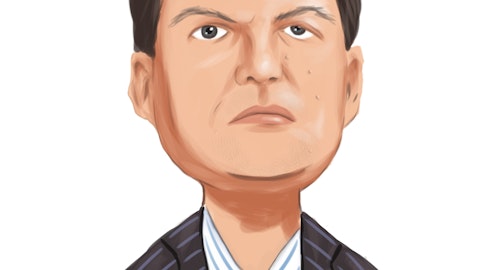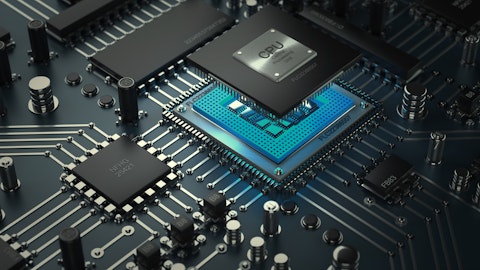Ananda Baruah: And are you guys seeing, just given all the activity in AI, are you seeing any greater urgency from your engagements around 1.6T? You know, you’ve given a lot of great context, actually, this calendar year, with regards to sort of timelines, industry 1.6T adoption. You made reference, I think, in the slide deck today to 3.2T. Any greater urgency there given what’s going on in AI and any context around your, kind of, market positioning with regards to that. And that’s it for me, thanks.
Chuck Mattera: Okay. Thanks, Ananda. Sanjay?
Sanjai Parthasarathi: Yes, sure. Thanks, Ananda, for the question. So one thing is very clear. With AI, we need to go higher and higher speeds, and it needs to happen, you know, earlier. We’re making great progress towards our 1.6T. We believe that we’ll be one of the first ones out there. And in terms of timing, we’re looking at — we think the market will be trying to inflect in 1.60T around fiscal ‘25. And I just want to say we’ve got all the key enabling blocks, especially the DFB-Mach-Zehnder laser, which is a 200G laser that we demonstrated at ECOC. So we’re making good progress there. Hopefully, that helps.
Ananda Baruah: That’s great. Appreciate it, guys. Yes, no, that’s super helpful. Appreciate it.
Chuck Mattera: Thanks, Ananda.
Sanjai Parthasarathi: Thank you.
Chuck Mattera: Thank you.
Operator: 1 moment for our next question. Our next question comes from Dave Kang with B. Riley. Your line is open.
Chuck Mattera: Good morning Dave.
Dave Kang: Good morning. Yes, good morning. Thank you. Just regarding your data comics, I was wondering if you can provide by what the mix was between 100 gig, 400 gig, 800 gig?
Chuck Mattera: Yes. Please, Sanjai.
Sanjai Parthasarathi: So the high speed which we define as 200G and above was 70% of their avenues last quarter.
Dave Kang: So I assume the remaining 30% is 100 gig [Indiscernible]. How should we think about, I mean, first of all, are they growing? And what do you think their runway is, and how should we think about pending decay eventually?
Sanjai Parthasarathi: Yes, I mean, the slower speeds are typically today non-AI related, so they’re not growing as fast as 800G and even some parts of 400G. But long-term, we still believe those speeds are still going to continue to grow. Especially the AI kind of moves towards the edge of the networks.
Dave Kang: Got it. And my follow-up is regarding your CapEx. How should we think about CapEx for this fiscal year? And then fiscal ‘25 after you get that $1 billion investment from two Japanese companies? How will that drop off in ‘25 after silicon carbide investments?
Chuck Mattera: Okay, two great questions, Dave. Rich, will you take those?
Rich Martucci: Yes. So as of right now, we’re still holding to the full-year guidance that we previously gave of $350 million to $400 million for FY ‘24. On the silicon carbide for FY ‘25, obviously the investment will offset or what we thought we were going to invest in ‘25.
Chuck Mattera: Dave, when we close, we will run through in that next quarter revisions to our guidance. And in the reporting quarter after the close, we’ll update and give a strong sense for what we see both for ‘24 and give at least a glimpse of ‘25. Okay?
Dave Kang: Got it. Thank you.
Chuck Mattera: Yes. Thank you, Dave.
Paul Silverstein: Kevin, can we go on to the next speaker?
Operator: Our next question comes from Tim Savageaux with Northland Capital Markets. Your line is open.
Chuck Mattera: Good morning, Tim.
Operator: Tim, your line is on mute.
Chuck Mattera: Good morning, Tim.
Tim Savageaux: Sorry about that. Good morning, a couple of math questions here. I think with some significant implications maybe. First one is on results and guide telecom versus datacom. And I think the anecdotal commentary is about inventory digestion on the cloud side, but if you look at how that’s proceeding, it seems like most of the weakness sequentially was in telecom, going from 40% to 29% on a declining number. So, we talk in order book versus revenues and we’re talking about those comments. Am I looking at that right? As you look at the guide, is most of that sequential growth, about $75 million bucks, is that in comms and is that some AI starting to shift or telecom bouncing back or how will we characterize that? And I have a follow up.
Chuck Mattera: Okay, well I think there’s really two questions. Beck will take the one that’s market related and Rich will take the finance.
Beck Mason: Sure, I mean on the telecom side, we see that growing, you know, modestly this quarter and then we see double-digit growth recovery in the second-half of this fiscal year for our telecom revenues, right? And I can comment on the ratio that was relative to the revenue last quarter.
Chuck Mattera: Exactly. Okay. Tim, would you repeat the second part of your question for Rich?
Tim Savageaux: Let me go on to the third part. And of course, there’s a Rich history of multi-part questions here with numbers of this call. But and that is the overall question I’m saying I’m going to ask is what is the absolute size of your AI backlog, but I’m going to try and get there in a couple of parts which is you talked about an order increase last quarter that was entirely networking driven, 30%. That seems like it’s $300 million. There’s some commentary here in the call about, despite orders coming down, the AI backlog going up 200%. So I’m going to give you a chance here just to give us a number for what you got in backlog that you would consider AI, whether that’s all 800 gig or not?
Chuck Mattera: Yes, I don’t think we can give you that. What I can tell you is it’s a substantial and meaningfully material one-off. But I’m not going to give you the number.
Tim Savageaux: Okay, thanks.
Chuck Mattera: Okay, thank you, Tim.
Operator: One moment for our next question. Our next question comes from Jim Ricchiuti with Needham & Company. Your line is open.
Jim Ricchiuti: Hi, Thanks. Good morning. So you seem to be suggesting some recovery in the second-half on both the OLED side and the WFE side of the business? The OLED side, I think we understand what’s happening with service utilization going up. What’s your line of sight in terms of deployment of new Excimer laser tools in the second-half of fiscal ‘24, as well as your line of sight on the WFE improvement in the second-half?
Chuck Mattera: Yes, as you mentioned, service utilization, uptick in the Excimer business for display in the near-term. In the long-term, the principal movements in the display market will be around the adoption of OLED technology in laptops, in tablets, in IT panels. And we are engaging with customers on Gen 8 investments. The timing of those Gen 8 investments should be clear early calendar year ‘25 and we’ll be well positioned to work with our customers on the expansion of OLED capacity for tablets and for laptops, which would be incremental to our current business. We’ve developed solid state technology in line with the challenges of maintaining a sensible cost level for those larger OLED panels. And in the long-term, we see migration with TVs into the micro LED markets, which we’re investing heavily in developing new tools for. Jim, did you have a second one?



